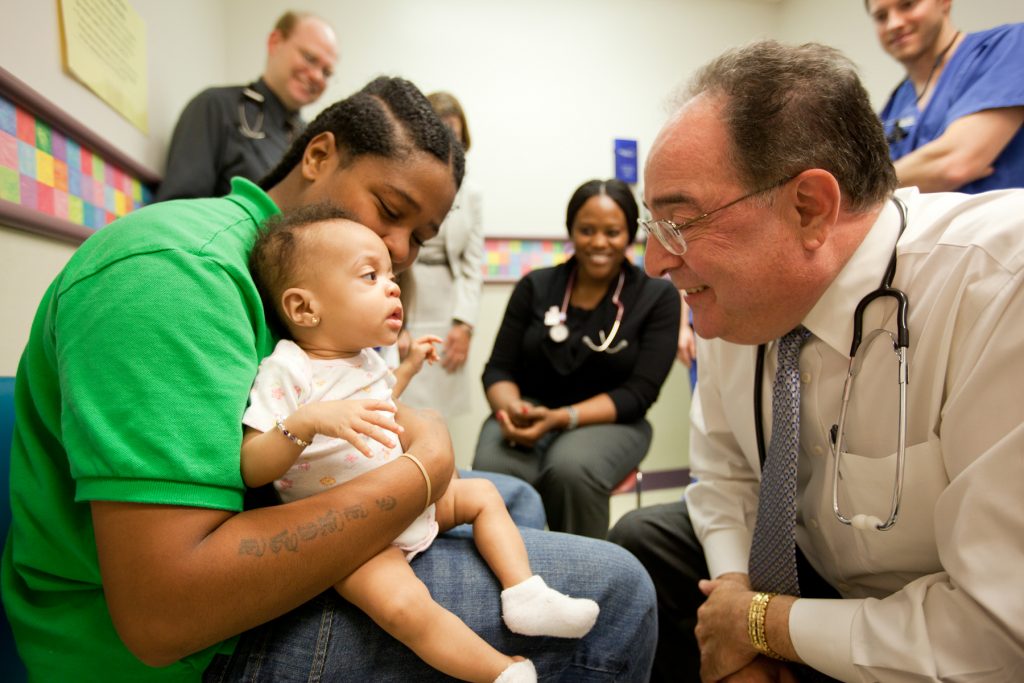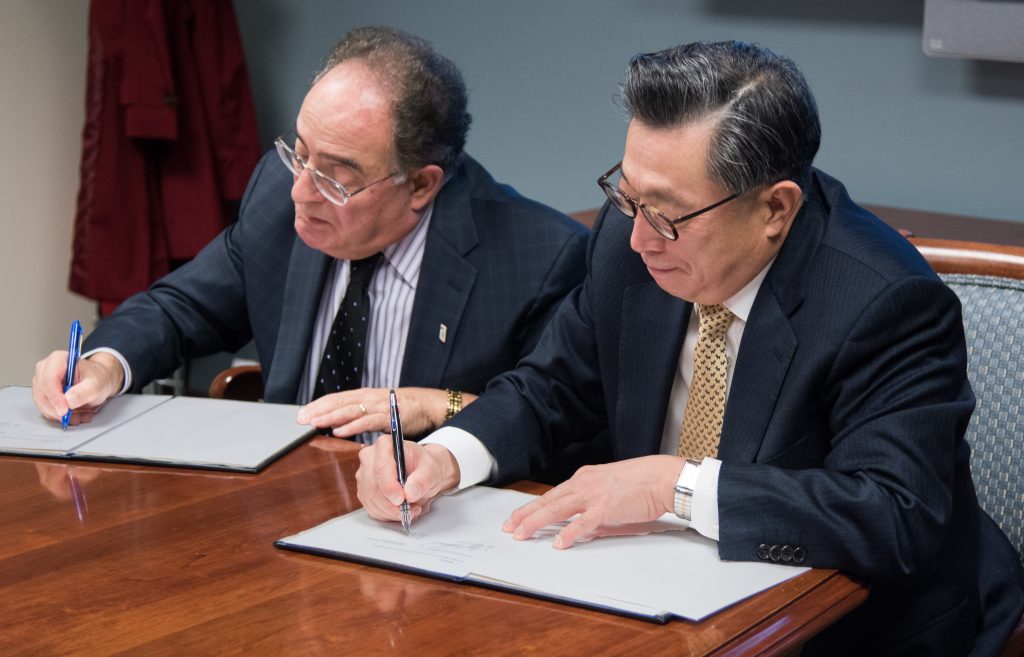With a focus on collaboration, community, and civility, Dr. Jay Perman’s presidency made an impact that continues to resonate at UMB.

Dr. Jay Perman’s 10 years as president of the University of Maryland, Baltimore (UMB) were remarkable not just for what he achieved, but also how he achieved it. He built such strong allegiances that the smiles at his inauguration in 2010 turned to tears at his farewell ceremonies in December 2019 before Perman moved “one flight up” to become chancellor of the University System of Maryland (USM).
How special was he as president? Whether he was meeting a corporate executive abroad or a neighbor around the corner, he could relate to them. This interest in others, what 2010 Founders Week Gala emcee Gerry Sandusky described as “a people person who leads with his ears,” won over countless associates.
Rev. Alvin Hathaway, DMin, PhD, of Union Baptist Church near UMB, recalls his first meeting with Perman. The two were looking out of Perman’s 14th-floor windows. “He easily could have turned east, which is where the campus is,” Hathaway said. “But he turned to the west and said, ‘These are the areas I want to impact.’ He held true to his word.”
Months later at his inauguration, amid the pomp and regalia at the Hippodrome Theatre, Perman laid out the course of his presidency in simple terms. Silos were out; interdisciplinary teams were in. Check your egos; civility must reign. UMB’s impact must be both near and far, or in Perman’s words, “We must be a University that is internationally respected and locally loved.”

Perman didn’t just mouth the words, however. He led by example. To teach interdisciplinary care, Perman, a pediatric gastroenterologist, would gather students from UMB’s six professional schools each Tuesday at the President’s Clinic with nurse practitioner Elsie Stines, DNP, CRNP, treating pediatric patients.
“It’s a way for me to make a statement to the entire campus that I consider collaboration to be so important that I do it myself,” he said in an interview for Maryland magazine in July 2010, a week into his tenure. “Plus I enjoy it!”
He also enjoyed annual Interprofessional Education (IPE) Days where hundreds of students from UMB’s schools would gather in small groups to assist actors playing the role of patients. The students gained a new appreciation for their fellow students in different disciplines. “Here’s what I learned,” a master’s student in nursing told Perman. “The pharmacy students know everything.”
Listening and Responding
Perman’s presence at IPE Day wasn’t an anomaly. He would pop up everywhere on campus. He hosted Q&As and brown bag lunches. There even was an Ask a Question website. Nothing was off the table. Unionizing employees, pay raises for custodial staff, day care, sexual harassment. All were addressed. He wrote a column in his monthly President’s Message explaining that he accepted an award from the Boy Scouts just so he could berate the organization for its anti-gay policies.
He would listen and he would respond.

So when the Maryland General Assembly in 2011 raised the possibility of merging UMB with the University of Maryland, College Park (UMCP), Perman held a town hall where neighbors, politicians, community leaders, and University members made their case for keeping UMB separate and distinct from College Park.
The resulting University of Maryland Strategic Partnership Act of 2016 raised the research profile of UMB and UMCP — which together attract more than $1 billion annually in grants and contracts. It also formalized the hugely successful partnership MPowering the State, begun in 2012 between the two institutions, creating joint projects and accelerating economy-driving tech-transfer activity.
In Fiscal Year 2018, UMB achieved a record-shattering $667.4 million in grants and contracts, not only the largest total ever recorded by UMB, but also the most by a USM institution. The numbers, while important, were secondary, Perman said. “More than dollar value, we measure them by their power to improve people’s lives.”
Seed grants paired a UMB faculty member with one from College Park. There were more joint projects among UMB schools and the opening of Health Sciences Research Facility III, the largest biomedical research facility in the system, in 2018.
It’s what Perman alluded to in his inaugural speech, titled “Leadership by Collaboration,” when he recalled the admonishment of author Robert Fulghum, who wrote, “It is still true, no matter how old you are, when you go out into the world it is best to hold hands and stick together.”

Collaboration also was at the forefront when, at Perman’s request, groups from all parts of the University crafted a 2011-2016 Strategic Plan to make UMB “greater than the sum of its parts.”
A 2017-2021 plan would follow.
He established seven core values — accountability, civility, collaboration, diversity, excellence, knowledge, leadership — and built a speaker series of esteemed guests around them.
Having formed a Diversity Advisory Council (DAC) shortly after his arrival as president, Perman began a DAC Speaker Series in 2016, one of many actions he initiated after the Freddie Gray unrest in the city.
He worked closely with his special assistant and senior vice president for external affairs, Jennifer Litchman, MA, to identify areas of need within the University, and together they established UMB’s Roundtable on Empowerment in Leadership and Leveraging Aspirations (UMBrella) to create pathways to success for women and those who identify as women, to help them achieve their potential. (This organization was the precursor to the President’s Council for Women, which Perman established in 2019, to foster an environment of equity, opportunity, and fulfillment for all women at UMB.) They also established the Council for the Arts & Culture, and invited Maryland first lady Yumi Hogan to be the honorary chair.

Emphasis on Students
Students always came first because “they are the only ones who pay to be here,” Perman said. The GRID (Graduate Research Innovation District) for entrepreneurs and an Intercultural Center came from student requests. He’d even host Saturday brunches for students at his home with his wife, Andrea.
Through it all, Perman never forgot where he came from. “I am a first-generation American, the only child of immigrant parents who struggled to make a living, my father in a hand laundry and my mother as a seamstress,” Perman told new U.S. citizens at a naturalization ceremony at Westminster Hall in 2018. Only through scholarships was Perman able to go to college and medical school.
So presenting opportunity to those who couldn’t rise without it became a hallmark of his administration.
He began with youths in the UMB CURE Scholars Program. Launched in 2015, it was the first National Cancer Institute Continuing Umbrella of Research Experiences (CURE) program in the country to engage scholars beginning in sixth grade, seeking to guide them into medical and public health careers. The scholars from three West Baltimore middle schools stayed after school twice a week for science projects with their UMB mentors. They spent Saturdays and summers on campus for tutoring, lab tours, and field trips.
By adding one class each year, today the program stretches from middle school through high school with that first cohort of sixth-graders now in college, something that seemed out of reach for these students before UMB CURE Scholars.
Local and Global Impacts

But opportunity isn’t only for the young. So Perman opened a modest, 3,000-square-foot Community Engagement Center (CEC) in fall 2015 near the BioPark. At first only a few people came despite window signs saying, “Free resources for members of our community.”
Said Perman: “So we went door-to-door and asked neighbors why they weren’t stopping in. And they said, ‘We didn’t know that was for us.’ ” Now, they know. In its first four years, the center recorded 35,000 visits for workforce development, fitness/health classes, food markets, and more.
In fact, so many came that the CEC outgrew its space. So in 2019, Perman presided over the groundbreaking of what is now an architecturally stunning, 20,000-square-foot CEC space that helps neighbors and students.
Said Perman: “The center helps students understand the challenges our neighbors face and what those challenges mean in terms of their own professional — and cultural — competency.”
Building UMB’s Global Footprint

Students also benefited from traveling much farther than around the corner. In Perman’s first year, there were UMB student medical missions to Honduras and Malawi. By 2014, 450 faculty, staff, and students at UMB made 800 trips to 103 countries — to teach, study, and conduct research. The students in Perman’s 2017-2018 President’s Symposium and White Paper Project focused on global literacy, and he applauded 2017 grantees from the Center for Global Education Initiatives, saying “students come back from these trips with things that they would have never figured out here.”
Perman traveled as well as he worked to expand UMB’s impact on a global scale. In 2015, he joined Gov. Larry Hogan’s 10-day investment and trade trip to Asia. In 2018, he led a UMB leadership team to four Asian cities. The following year, it was a weeklong trip to Zambia and Botswana. Previously he had accompanied Gov. Martin O’Malley to Israel, China, and South Korea.
And whether it was meeting young mothers in a simple clinic in Zambia or Pharmaron executives in a fancy boardroom in Beijing, Perman won over his audience. His secret weapon? “He just connects with people,” James Hughes, MBA, senior vice president and chief enterprise and economic development officer, said in Perman’s farewell video.
Gratitude has always been central to Perman’s efforts to build UMB’s presence in the West Baltimore community, nationally, and globally.
He was as grateful to accept a $2 gift from a West Baltimore resident for “growing a seed” at UMB as he was to receive multimillion-dollar grants from the National Institutes of Health and the Bill and Melinda Gates Foundation, because it all ended up supporting UMB’s mission of improving the human condition and serving the public good.




